Banana Bread Recipe: a timeless classic, has delighted palates for generations with its moist texture and sweet banana flavor. It’s a staple in home baking that provides a use for overripe bananas and offers endless possibilities for customization. Whether you’re an experienced baker or trying your hand at this comforting treat for the first time, this ultimate guide will walk you through the essentials of crafting the perfect loaf of banana bread, from understanding the ingredients to exploring a variety of adaptations for dietary preferences.
Key Takeaways
- The perfect banana bread starts with understanding the role of each ingredient and the importance of using overripe bananas for optimal sweetness and moisture.
- It is crucial to achieve the right batter consistency; it should be mixed just enough to moisten the dry ingredients, as overmixing can lead to a dense loaf.
- Customization options abound, from adding nuts and chocolate chips to experimenting with alternative sweeteners and flours for unique flavors and textures.
- Health-conscious bakers can create delicious banana bread by opting for whole wheat flour, and natural sweeteners, and incorporating vegan or gluten-free adaptations.
- Banana bread’s versatility extends beyond the classic loaf; it can be transformed into muffins, cupcakes, and other banana-based bakes for various treats.
The Basics of Banana Bread

Understanding the Ingredients
The journey to a delightful banana bread begins with a clear understanding of its components. Each ingredient plays a crucial role in the bread’s texture, flavor, and rise. Flour provides the structure, baking soda acts as a leavening agent, and cinnamon adds a hint of spice. The sweetness and moisture come from sugar and ripe bananas, while eggs bind the mixture together.
The choice of oil, such as canola, is essential as it contributes to the bread’s moistness without overpowering the banana flavor.
Incorporating sour cream can add a subtle tang and tender crumb to your loaf, and vanilla extract infuses it with a warm aroma. For those who enjoy a bit of crunch, toasted walnuts are a popular addition. Below is a basic list of ingredients typically used in banana bread:
- All-purpose flour
- Baking soda
- Ground cinnamon
- Kosher salt
- Sugar
- Eggs
- Canola oil (or other flavorless oil)
- Ripe bananas
- Sour cream
- Vanilla extract
- Toasted walnuts (optional)
Remember to consider dietary restrictions or preferences when selecting your ingredients, as there are many substitutions available for creating healthier or allergy-friendly versions of this classic treat.
The Importance of Ripe Bananas
The key to moist and flavorful banana bread lies in the ripeness of the bananas. As bananas ripen, the starches inside convert to sugars, providing natural sweetness and a richer taste. This process also softens the fruit, making it easier to mash and blend into your batter.
To ensure your bananas are at the perfect stage of ripeness, look for ones that are very yellow with plenty of brown spots. If you find yourself with underripe bananas, don’t fret. You can accelerate the ripening process by baking unpeeled bananas on a cookie sheet at 300F for 15-30 minutes. Once the skins turn black and the bananas are soft, they’re ready to be transformed into delicious banana bread.
Using ripe bananas not only enhances the flavor but also contributes to the perfect texture of your banana bread, making it a crucial step in the baking process.
Mixing Techniques: Wet into Dry
The key to moist and tender banana bread lies in the proper mixing of wet and dry ingredients. Begin by whisking together your dry ingredients in one bowl, ensuring they are well combined. In a separate bowl, mash the bananas and mix with the other wet ingredients.
When combining the two, pour the wet mixture into the dry ingredients and use a spatula to fold them together gently. This method prevents overmixing, which can lead to a dense and tough loaf.
Here’s a simple guide to follow:
- Whisk dry ingredients until evenly mixed.
- Mash bananas and combine them with other wet ingredients.
- Gradually pour wet into dry, folding with a spatula.
- Stop as soon as you see no more dry flour.
By following these steps, you’ll ensure that your banana bread has the perfect texture every time.
Banana Bread Recipe: Crafting Your Loaf

Preparing the Pan and Oven
Properly preparing your pan and oven is a crucial step in crafting your ultimate banana bread. Preheat your oven to the right temperature, typically around 325-350 degrees Fahrenheit, to ensure even baking. The position of the oven rack is equally important; it should be in the lower third or center of the oven to prevent the top of the bread from browning too quickly.
Before pouring your batter into the pan, make sure to grease it well with nonstick spray or butter, and consider lining it with parchment paper for easy removal. Here’s a quick checklist to ensure your pan and oven are ready:
- Adjust the oven rack to the desired position.
- Preheat the oven to the specified temperature.
- Grease the loaf pan, or line it with parchment paper.
By taking the time to properly prepare your pan and oven, you’re setting the stage for a beautifully baked banana bread that’s golden on the outside and moist on the inside.
Combining Ingredients Step by Step
Crafting your loaf of banana bread begins with the meticulous process of combining ingredients. The order in which you add components is crucial to the texture and taste of your bread. Begin by creaming together butter and brown sugar until the mixture is smooth and creamy. This step sets the foundation for a moist loaf.
After creaming the butter and sugar, gradually introduce the eggs, one at a time, ensuring each is well incorporated before adding the next. The addition of eggs is followed by the yogurt, mashed bananas, and vanilla extract, which are mixed until just combined.
It’s essential to add the oil slowly into the mixture to maintain the airiness achieved from creaming. Stream the oil over a minute to prevent deflation of the batter. Here’s a simple guide to follow:
- Cream butter and brown sugar
- Add eggs one at a time
- Mix in yogurt, mashed bananas, and vanilla
- Slowly stream in the oil
Lastly, with the mixer on a low setting, carefully blend the dry ingredients into the wet mix to avoid forming flour pockets. The goal is to achieve a uniform batter without overmixing, which can lead to a dense loaf.
Tips for the Perfect Batter Consistency
Achieving the perfect batter consistency is crucial for a delectable loaf of banana bread. The batter should be thick enough to hold its shape but not so dense that it becomes heavy. Here’s a simple guide to ensure your batter is just right:
- Start by gently folding the dry ingredients into the wet mixture until just combined. Over-mixing can lead to tough bread.
- The batter should be slightly lumpy; it’s okay if there are a few streaks of flour.
- If the batter seems too dry, add a tablespoon of milk or buttermilk to adjust the consistency.
When you pour the batter into the pan, it should spread slowly. If it runs quickly, it may be too thin, and if you have to force it, it’s too thick.
Remember to check for doneness with a toothpick inserted in the center. If it comes out clean, your banana bread is ready to be taken out of the oven. Gently tapping the pan a few times on the counter will help settle the batter and smooth out the top.
Customizing Your Banana Bread

Incorporating Nuts and Chocolate Chips
Enhancing your banana bread with nuts and chocolate chips can transform it from a simple snack into a decadent treat. The addition of these ingredients not only introduces new textures but also complements the natural sweetness of the bananas.
When incorporating chocolate chips, consider the variety that best suits your taste. Milk chocolate chips offer a sweeter, creamier bite, while dark chocolate provides a rich, intense flavor. For those who prefer a nutty crunch, walnuts or pecans are classic choices that bake well within the bread.
To achieve the perfect distribution of chocolate chips and nuts, gently fold them into the batter as the last step before pouring it into the pan. This ensures that every slice is studded with these delicious morsels.
If you’re looking to customize further, here’s a simple guide:
- For a richer flavor, add 1 cup of your favorite chocolate chips.
- To introduce a nutty texture, mix in 3/4 cup of chopped nuts like pecans or walnuts.
- For a healthier twist, consider using dark chocolate chips and a mix of seeds such as sunflower or pumpkin.
Remember, these add-ins are optional, and you can adjust the quantities to suit your preferences. Some bakers even recommend using a combination of nuts and chocolate chips for a truly indulgent loaf.
Alternative Sweeteners and Flours
When crafting your ultimate banana bread, you have the freedom to experiment with various sweeteners and flours to suit your dietary preferences or to simply shake things up. Opting for alternative sweeteners can reduce the refined sugar content, making your loaf a healthier treat. Liquid sweeteners like honey or maple syrup are popular choices, and they bring their unique flavors to the bread.
For those looking to avoid gluten or just wanting to try different flour options, several substitutes work well in banana bread. A mix of gluten-free all-purpose flour, oat flour, or even an almond meal can replace traditional wheat flour. It’s important to note that each alternative flour will affect the texture and flavor of your bread, so you may need to experiment to find your perfect blend.
While traditional recipes call for white or whole wheat flour, don’t hesitate to explore the variety of flours available. From spelt to coconut flour, each brings a distinct taste and nutritional profile to your banana bread.
Remember, the key to successful banana bread is in the balance of ingredients. Whether you’re using a different sweetener or flour, make sure to adjust the recipe accordingly to achieve the desired consistency and sweetness.
Creative Variations and Add-Ins
Banana bread is a versatile canvas for creativity. Experiment with mix-ins to discover new flavors and textures. Consider folding in a handful of blueberries for a burst of tanginess, or swirl in some peanut butter for a rich, nutty twist. Here’s a simple guide to inspire your next creation:
- Blueberries: Add a pop of color and a tangy kick.
- Peanut Butter: Swirl in for a creamy, nutty flavor.
- Chocolate Chips: For a classic sweet touch.
- Chopped Nuts: Walnuts or pecans for a satisfying crunch.
- Coconut Flakes: A tropical flair with a chewy texture.
- Cinnamon Swirl: A warm spice that complements banana perfectly.
Embrace the freedom to personalize your loaf. The key is to add these ingredients after you’ve created a smooth batter, gently folding them in to maintain the batter’s consistency.
Remember, the add-ins should complement, not overwhelm, the banana flavor. Start with a small amount and adjust according to your taste preferences. Happy baking!
Healthy Banana Bread Options

Choosing Healthier Ingredients
When crafting a healthier version of banana bread, choosing the right ingredients is crucial. Opt for whole wheat flour instead of all-purpose for added fiber and nutrients. Sweeten naturally with ripe bananas and consider reducing added sugars or using alternatives like honey or maple syrup. Unsweetened applesauce can replace oil, maintaining moisture without the fat.
Embrace the versatility of banana bread by experimenting with various healthy add-ins. Chia seeds, flaxseeds, or walnuts can introduce omega-3 fatty acids, while blueberries or dark chocolate chips add antioxidants.
For those practicing Intermittent Fasting for Weight Loss, this banana bread can be a satisfying treat that fits within your eating window. Remember to adjust portion sizes and ingredients to align with your dietary goals.
Here’s a quick list of ingredient swaps for a healthier loaf:
- Whole wheat flour instead of white flour
- Unsweetened applesauce or mashed avocado for oil
- Natural sweeteners like honey or maple syrup
- Add-ins such as nuts, seeds, or fresh fruit for extra nutrition
Vegan and Gluten-Free Adaptations
Adapting your banana bread recipe to suit vegan and gluten-free diets is simpler than you might think. For a vegan version, replace eggs with flax eggs or a commercial egg replacer. Dairy products can be substituted with plant-based alternatives like almond or soy milk, and coconut oil or vegan butter can take the place of traditional butter.
Gluten-free adaptations require a bit more attention to detail. Swap out wheat flour for a gluten-free all-purpose blend, ensuring it contains xanthan gum to mimic the texture of gluten. Keep an eye on the batter consistency, as gluten-free flours can absorb liquids differently.
To ensure success, measure your ingredients carefully and don’t be afraid to adjust the liquid content slightly to achieve the perfect batter consistency.
Here’s a quick checklist for vegan and gluten-free substitutions:
- Flax eggs or commercial egg replacer for eggs
- Plant-based milk (almond, soy, oat) for dairy milk
- Coconut oil or vegan butter for butter
- Gluten-free all-purpose flour blend for wheat flour
Remember to check the labels on your ingredients to confirm they meet your dietary requirements. With these simple swaps, everyone can enjoy a slice of delicious, healthy banana bread.
Reducing Sugar: Natural Sweeteners
When aiming for a healthier version of banana bread, reducing the amount of added sugar is a key step. Opting for natural sweeteners can provide a more nutritious alternative to refined sugars. Here are some natural sweeteners you can use in your banana bread recipe:
- Honey: Adds a rich, floral sweetness and contains trace nutrients.
- Maple syrup: Provides a unique, earthy sweetness along with minerals.
- Applesauce: Offers a subtle sweetness and additional moisture, making it a great substitute for both sugar and oil.
By using these natural sweeteners, you not only cut down on processed sugar but also infuse your banana bread with unique flavors and textures.
Many bakers have found success in creating delicious, moist banana bread by incorporating these healthier ingredients. For instance, a No Sugar Added Banana Bread can be made using applesauce, which also allows the bread to be dairy-free and oil-free. Experimenting with different flour types, such as whole wheat or gluten-free blends, can also contribute to a healthier loaf without compromising on taste.
More Than Just Bread: Other Banana-Based Bakes

Banana Muffins and Cupcakes
Transforming the classic banana bread recipe into delightful muffins and cupcakes is a simple way to diversify your baking repertoire. These smaller treats are perfect for on-the-go snacking or serving at gatherings where individual portions are preferred.
To ensure your banana muffins rise nicely, start by baking them at a higher temperature for a short burst before reducing the heat. This technique gives them a beautifully domed appearance.
Here’s a quick guide to adapting your banana bread recipe for muffins:
- Preheat your oven to 425°F (218°C) and prepare your muffin pan with liners or a light greasing.
- Fill each muffin cup to the top with your banana bread batter.
- Bake for 5 minutes at the initial high temperature.
- Without opening the oven, reduce the temperature to 350°F (177°C).
- Continue baking for an additional 16–17 minutes, or until a toothpick comes out clean.
The total bake time will be approximately 21–23 minutes. Remember, the initial high heat is the secret to a perfect muffin top. For those with a sweet tooth, consider adding a cup of chocolate chips to the batter, or for a healthier twist, opt for nuts or blueberries.
Banana Bread with Sour Cream
Incorporating sour cream into your banana bread recipe can transform the texture into a light and fluffy delight. This ingredient, often used in various baked goods, ensures that your loaf remains moist and tender.
To achieve the perfect sour cream banana bread, start with these essential ingredients:
- Butter
- White sugar
- Eggs
- Sour cream
- Ripe bananas
- All-purpose flour
- Baking powder
- Salt
- Baking soda
The key to a velvety texture lies in the balance of wet and dry ingredients, with sour cream acting as the secret weapon for that extra tenderness.
While sour cream is a staple for many, alternatives like yogurt can also be used to maintain moisture. If you find yourself without sour cream or yogurt, other substitutes such as mashed banana, applesauce, or pumpkin puree can be used to keep your banana bread from drying out.
Quickbread Recipes Beyond Banana
While the classic banana bread recipe is a beloved staple in many kitchens, the world of quickbreads offers a delightful variety of flavors and textures to explore. Quickbreads are a fantastic way to experiment with different ingredients, creating unique and delicious treats that go beyond the traditional banana bread.
Quickbreads are not only easy to make but also incredibly versatile. Whether you’re in the mood for something nutty, fruity, or even chocolatey, there’s a quickbread recipe waiting for you.
Here are some popular alternatives to banana bread:
- Pistachio Bread
- Glazed Lemon Poppy Seed Bread
- Grandma Wilhelm’s Pumpkin Bread
- Healthier Oatmeal Chocolate Chip Muffins
- Pumpkin Banana Muffins
- Best Ever Pear Bread
Each of these recipes can be a delightful way to diversify your baking repertoire and enjoy the simplicity and comfort of homemade quickbreads.
Conclusion
As we wrap up our ultimate guide to banana bread, we hope you feel inspired to create your delicious loaf. Whether you follow the classic recipe or experiment with variations like adding nuts, chocolate chips, or even sour cream, the key is to remember the simple joy of baking. The process should be as enjoyable as the outcome—a warm, moist, and flavorful banana bread that’s perfect for any occasion. With the tips and techniques shared in this guide, you’re well-equipped to bake a banana bread that’s not only a treat for the taste buds but also a testament to the timeless appeal of this beloved comfort food. So preheat your oven, mash those ripe bananas, and get ready to enjoy the fruits of your labor!
Frequently Asked Questions
What is the key to achieving the perfect batter consistency for banana bread?
The key to perfect batter consistency is to mix the dry ingredients with the wet ingredients just until they are moistened. Overmixing can lead to a dense loaf, so stir the batter gently until it’s just combined.
Can I add nuts or chocolate chips to my banana bread?
Absolutely! Feel free to customize your banana bread by adding chopped nuts like walnuts or pecans, chocolate chips, raisins, or even slices of bananas for extra texture and flavor.
How can I make my banana bread healthier?
To make banana bread healthier, you can use whole wheat flour, natural sweeteners like honey or maple syrup, and incorporate ingredients such as sour cream or ripe bananas to add moisture without excess fat.
What are some creative variations of banana bread I can try?
Beyond the classic recipe, you can experiment with adding sour cream for extra moisture, using alternative flours like almond or coconut flour, or creating fun variations like pumpkin banana muffins or pistachio bread.
How do I know when my banana bread is fully baked?
Banana bread is done when a toothpick inserted into the center comes out clean, or with a few moist crumbs attached but no wet batter. The top should be golden brown, and the edges should start to pull away from the pan.
Can banana bread be made vegan or gluten-free?
Yes, you can make vegan banana bread by substituting eggs with flax eggs and using dairy-free alternatives for butter and milk. For gluten-free banana bread, substitute the all-purpose flour with a gluten-free flour blend.




